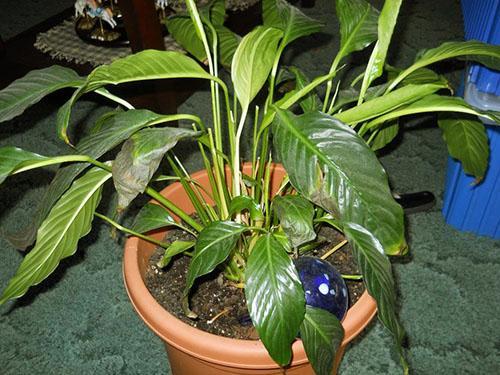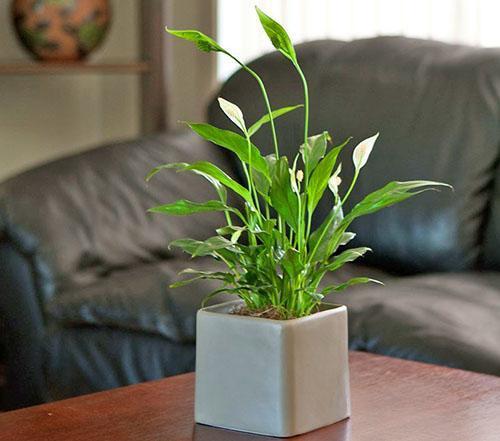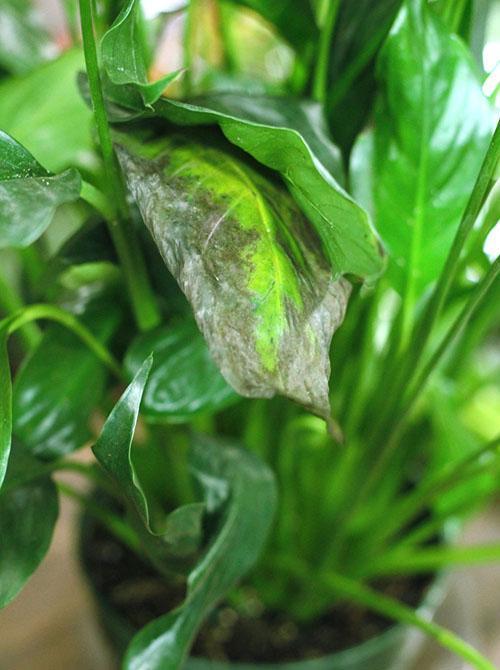In spathiphyllum, the tips of the leaves turn black, how to help the plant and what to do
 Spathiphyllums, natives of the humid South American tropics, where plants can be found in dense undergrowth, on swamps and the banks of water bodies, have taken root well in indoor conditions. Plants from the Aroid family in nature are completely dependent on the presence of heat, moisture and ambient light.
Spathiphyllums, natives of the humid South American tropics, where plants can be found in dense undergrowth, on swamps and the banks of water bodies, have taken root well in indoor conditions. Plants from the Aroid family in nature are completely dependent on the presence of heat, moisture and ambient light.
For rapid active growth and flowering, they need a loose, fairly nutritious soil, and if these conditions are met, spathiphyllum feels great on the windowsill, without requiring any special, laborious care.
Features of cultivation and possible problems

- dark green color of pointed lanceolate leaves;
- regular flowering of spathiphyllum, accompanied by the appearance of an elongated inflorescence-cob, as if wrapped in a graceful white bracts;
- the appearance of new leaves;
- rapid growth of the bush.
And yet the flower can sometimes seriously disturb the owner. Mistakes made when caring for spathiphyllum, diseases and pest infestations cannot but affect the well-being and appearance of the plant.
The first to signal the problem are the leaves, which begin to turn yellow, blacken and dry. If you do not take timely measures, the inflorescences wither, and if the roots are damaged, there is a risk of losing a healthy green bush altogether.
 Quite often, flower growers are faced with a problem when the tips of the leaves turn black in spathiphyllum, how to help the plant and what should be done in this situation? There may be several reasons for this behavior of a plant. The most common is excessive soil moisture, due to which the root system does not develop well, and the existing roots at the points of growth turn black and rot. This cannot but affect the health of the aboveground part of the bush. The greens wither, and the tips of the spathiphyllum leaves dry up, becoming black and lifeless.
Quite often, flower growers are faced with a problem when the tips of the leaves turn black in spathiphyllum, how to help the plant and what should be done in this situation? There may be several reasons for this behavior of a plant. The most common is excessive soil moisture, due to which the root system does not develop well, and the existing roots at the points of growth turn black and rot. This cannot but affect the health of the aboveground part of the bush. The greens wither, and the tips of the spathiphyllum leaves dry up, becoming black and lifeless.
Care errors
 If the trouble happened after the temperature in the room dropped, it is reasonable to assume that the pot was simply flooded, and now it is necessary to reduce the frequency watering and try to remove excess moisture from the soil. For this, you can use sphagnum moss, which absorbs moisture from the soil surface. When the damage is not limited to the dried tips of the leaves of the spathiphyllum, but the roots are also affected, then, in addition to changing the irrigation schedule and pruning blackened foliage, you will have to examine the underground part of the bush, as well as the base of the petioles.
If the trouble happened after the temperature in the room dropped, it is reasonable to assume that the pot was simply flooded, and now it is necessary to reduce the frequency watering and try to remove excess moisture from the soil. For this, you can use sphagnum moss, which absorbs moisture from the soil surface. When the damage is not limited to the dried tips of the leaves of the spathiphyllum, but the roots are also affected, then, in addition to changing the irrigation schedule and pruning blackened foliage, you will have to examine the underground part of the bush, as well as the base of the petioles.
The roots are carefully washed, the blackened ones are cut off and the healthy areas are treated with charcoal powder. Then the plant can be planted in the ground, remembering that it must be loose, because blackening of the leaves is more often observed in spathiphyllums growing in heavy soil that becomes very dense after watering. Do not forget about a powerful drainage layer that ensures the outflow of excess moisture from the roots.
It is recommended to treat the damaged plant and the soil under it with a fungicide to prevent the risk of developing parasitic fungi.
Understanding the reasons why the tips of the leaves turn black in spathiphyllum, and what to do with a plant that has lost its attractiveness, one must also remember about the temperature of the bush.For better health, the spathiphyllum should be kept in a room closed from drafts, where the temperature in winter will not drop below 7.5-10 ° C, depending on the type of plant. And the optimal daytime temperature in summer is 20-29 ° C. At night, a decrease of 2–4 degrees is permissible.
If the spathiphyllum turns out to be in uncomfortable conditions for it, for example, on a brightly lit window, burns of the leaf plates cannot be avoided.
Such spots also have a brown or almost black tint, especially when the bush is severely damaged by sunlight. This is the easiest problem to solve. The pots with the plant are rearranged where the sun is more gentle, or between the glass and the pot they arrange a translucent screen shading the spathiphyllum.
What if the tips of the leaves of spathiphyllum turn black due to high doses of fertilizers?
 Indoor plants require almost four times less fertilizer than those grown in greenhouses, especially with hydroponic systems.
Indoor plants require almost four times less fertilizer than those grown in greenhouses, especially with hydroponic systems.
Before the sale, greenhouse plants are planted in transport pots, applying a special complex of prolonged-release fertilizers under the roots. Such substances, with regular watering, can ensure the safety of the bush for up to 4-6 weeks.
And then the owner of the flower needs to feed on their own. And here you can not overdo it, otherwise an excessive amount fertilizers will be the reason why the leaves of spathiphyllum turned black, which only yesterday delighted them with a healthy gloss and rich color. In addition, spathiphyllum reacts by slowing growth, necrosis not only on leaf plates, but also on parts of the root system. Moreover, already mature leaves respond more sharply to excess nutrition.
 Since the problem concerns both the green part of the plant and its underground organs, all affected areas must be examined and removed, and the concentration of fertilizers in the soil, if possible, should be reduced. After transplantation, the spathiphyllum is treated with an epin solution, and then the usual fertilizing schedule for the plant is established.
Since the problem concerns both the green part of the plant and its underground organs, all affected areas must be examined and removed, and the concentration of fertilizers in the soil, if possible, should be reduced. After transplantation, the spathiphyllum is treated with an epin solution, and then the usual fertilizing schedule for the plant is established.
From early spring to early autumn, spathiphyllum is fertilized twice a month, alternating mineral and organic additives, and microelements are introduced by foliar method. For the winter, when the plant is in relative dormancy, the bush should not be fertilized, and watering is reduced so as not to cause rotting of the roots and blackening of the tips of the leaves of the spathiphyllum.
Only with proper care and attentive attitude, even such an unassuming flower as spathiphyllum will regularly delight with flowering and not cause trouble to the owner.
What's with my flower? The tips of both young shoots and adult leaves turn black and dry. Not in a cold place, not near a radiator, not in direct sun, shower once a week, the soil is wet. What is he missing? How can I help you?
The article describes in detail all the reasons why the leaves of spathiphyllum can turn black. Your bush and general appearance is not very beautiful. Free it from the soil and examine the roots - most likely the problems come from there. Anything bad, cut and disinfect. Be sure to treat it with a fungicide and change the soil to fresh. You should also be careful with fertilizing - from an excess of fertilizer, the leaves signal immediately.